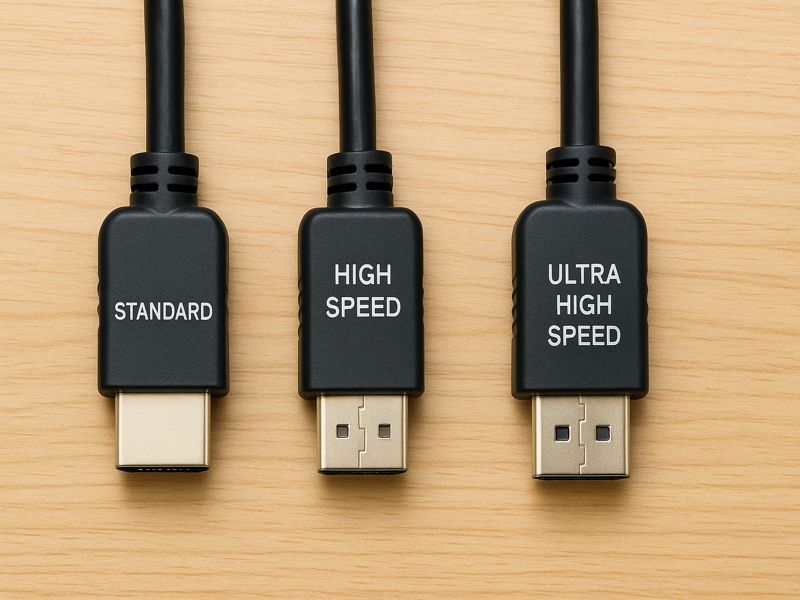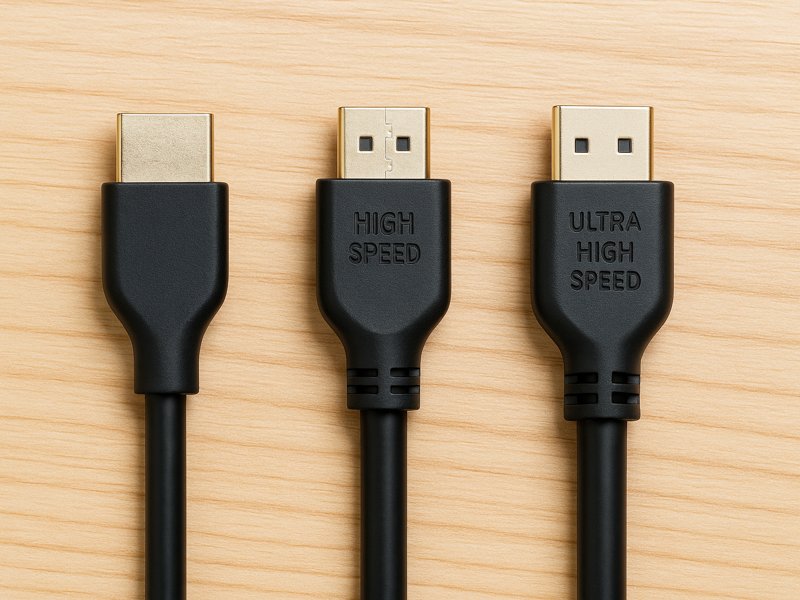Author: Site Editor Publish Time: 2025-10-24 Origin: Site








In the contemporary digital landscape, HDMI (High-Definition Multimedia Interface) cables are ubiquitous, found in everything from living room televisions and gaming consoles to conference room projectors and home theater setups. They are essential for relaying high-fidelity audio and video signals from one device to another. But with multiple categories on the market—Standard, High-Speed, and Ultra High-Speed HDMI cables—buyers often wonder: which cable is right for their needs?
This article provides a comprehensive guide to HDMI cable types, breaking down their specifications, use cases, and key differences. By the end, you’ll understand not just what each HDMI cable does but also how to choose the right one for your setup without overspending.
Before diving into cable types, it helps to understand what HDMI does:
Digital Transmission – HDMI transmits uncompressed video and compressed or uncompressed digital audio in a single cable.
Universal Compatibility – Nearly every modern TV, monitor, gaming console, and streaming device includes HDMI ports.
Evolving Standards – HDMI has evolved through multiple versions (1.4, 2.0, 2.1, etc.), each supporting higher resolutions, faster refresh rates, and advanced features.
Cable categories—Standard, High-Speed, and Ultra High-Speed—were introduced to help users match performance with device requirements.

Standard HDMI cables were the first category introduced and are now the most basic. Their features include:
Supports resolutions up to 1080i/720p
Bandwidth up to 4.95 Gbps
Ideal for HDMI versions 1.0–1.2a
Limited support for modern features like HDR or 3D
Standard HDMI cables are best suited for:
Older HDTVs (720p or 1080i)
DVD players and legacy gaming consoles
Projectors without Full HD capability
For modern 4K TVs, gaming consoles like PlayStation 5, or streaming devices, Standard HDMI cables are insufficient. They simply cannot carry the bandwidth required for today’s video and audio formats.
High-Speed HDMI cables became the industry standard as HDTVs advanced. They offer:
Supports resolutions up to 4K (30 Hz)
Bandwidth up to 10.2 Gbps
Compatible with HDMI versions 1.3–1.4
Can support 3D video, Deep Color, and ARC (Audio Return Channel)
High-Speed HDMI Cable – Basic version supporting 1080p and 4K at 30 Hz.
High-Speed HDMI with Ethernet – Introduces compatibility with the HDMI Ethernet Channel (HEC), allowing two linked devices to use a common Ethernet connection.
High-Speed HDMI cables are perfect for:
Set-top boxes and Blu-ray players
Streaming gadgets such as Roku, Apple TV, and Amazon Fire Stick
Mid-range 4K TVs (limited to 30 Hz refresh rates)
Soundbars and receivers using ARC
While High-Speed HDMI allows for 4K, it provides only 30 frames per second. That’s fine for movies but not ideal for gaming or high-motion video. For those use cases, a faster cable is needed.
Before Ultra High-Speed cables became mainstream, the Premium High-Speed HDMI cable was introduced as a certification program to guarantee performance.
Handles 4K at 60 Hz with HDR
Bandwidth of up to 18 Gbps
Works with HDMI 2.0/2.0a/2.0b
Certified with anti-counterfeit labels for authenticity
Premium High-Speed HDMI cables are great for:
4K Ultra HD TVs with HDR
Streaming in 4K at 60 Hz
Gaming consoles like PS4 Pro and Xbox One X
Home theaters requiring high-quality video and audio
This cable type became the standard recommendation for 4K TVs until HDMI 2.1 arrived with new demands.

Ultra High-Speed HDMI cables are made for the latest devices and the most challenging applications. Their features include:
Supports resolutions up to 8K at 60 Hz and 4K at 120 Hz
Bandwidth of up to 48 Gbps
Works with HDMI 2.1
Compatible with Dynamic HDR, eARC (Enhanced Audio Return Channel), along with VRR (Variable Refresh Rate).
Certified as resistant to electromagnetic interference (EMI)
Ultra High-Speed HDMI cables are crucial for:
Next-gen gaming consoles (PlayStation 5, Xbox Series X) that require 4K at 120 Hz
8K TVs and projectors
High-end PC gaming with GPUs supporting HDMI 2.1
Advanced home theaters with Dolby Atmos and DTS:X audio via eARC
Gamers benefit the most from Ultra High-Speed HDMI because of:
Low Latency Modes (ALLM) for smoother gameplay
VRR support to reduce screen tearing
High refresh rates (120 Hz) for fluid visuals
HDMI Cable Type | Max Resolution | Bandwidth | HDMI Versions | Key Features | Best For |
Standard HDMI | 1080i/720p | 4.95 Gbps | 1.0–1.2a | Basic HD video/audio | Legacy TVs and DVD players |
High-Speed HDMI | 4K at 30 Hz | 10.2 Gbps | 1.3–1.4 | 3D video, ARC, Deep Color | Streaming devices, 4K TVs (30 Hz) |
Premium High-Speed | 4K at 60 Hz + HDR | 18 Gbps | 2.0–2.0b | Certified performance, HEC | 4K HDR TVs, PS4 Pro, Xbox One X |
Ultra High-Speed | 8K at 60 Hz / 4K 120 Hz | 48 Gbps | 2.1 | eARC, VRR, ALLM, EMI resistant | PS5, Xbox Series X, 8K displays |
If you own an older HDTV (720p or 1080i), a Standard HDMI cable is enough.
For most 4K streaming and everyday use, High-Speed or Premium High-Speed will do.
For cutting-edge 4K gaming at 120 Hz or 8K content, Ultra High-Speed is mandatory.
Longer HDMI cables (over 15 feet) can lose signal quality. For longer cable runs, active HDMI or fiber optic HDMI cables are recommended.
Counterfeit cables are common. Always look for certified labels like Premium HDMI Certification or Ultra High-Speed Certification QR codes.
If you’re investing in a new TV or gaming console, consider buying an Ultra High-Speed cable even if you don’t yet need 8K. It ensures compatibility for years to come.
HDMI cables are more than simple wires—they are critical enablers of today’s high-definition and ultra-high-definition experiences. Choosing the right type—Standard, High-Speed, or Ultra High-Speed HDMI cable—depends on your devices, content, and future needs.
Standard HDMI is for legacy devices.
High-Speed and Premium High-Speed HDMI work for most current 4K setups.
Ultra High-Speed HDMI is the future-proof choice for next-gen gaming, 8K video, and advanced home theaters.
Buyers can make informed choices, prevent overspending, and maximize the potential of their entertainment systems by comprehending these distinctions.